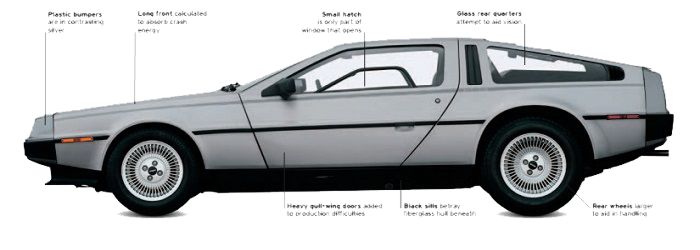It is difficult to separate the DeLorean from the financial scandal that engulfed it. Promoted as an “ethical” sports car-safe and durable-it was the brainchild of former General Motors high-flier John Zachary DeLorean, and was bankrolled by the British government, which paid for a brand-new factory in Northern Ireland.

Dubious business practices and unbridled extravagance were matched by unrealistic market expectations for the DeLorean. When sales-undermined by poor quality-failed to match the hype, the business crashed.

Founder’s logo
The symmetrical “DMC” logo was an abbreviation of “DeLorean Motor Company.” The model title was always DMC-12. John Z. DeLorean himself was associated with the development of several cars for GM’s Pontiac division.
THE DELOREAN entered production in 1981, retaining the gull-wing doors and stainless-steel cladding of the prototype unveiled in 1977. Little else remained, as the car was completely redesigned by Lotus pre-production. Initial plans had been for a mid-mounted Wankel engine, but the final powerplant was a Renault V6 hung behind the rear axle.
Despite this tail-heavy configuration, the car handled well. The British sports-car company ditched the DeLorean’s plastic body shell, which used a sandwich of fiberglass with a foam filling. It substituted this unproven technology with a traditional Lotus steel-backbone chassis and a two-piece, fiberglass body using its clever vacuum-assisted, injection-molding process.
| Model | DeLorean DMC-12, 1981-82 |
| Assembly | Dunmurry, Northern Ireland |
| Production | 9,000 approx, |
| Construction | Steel-backbone chassis |
| Engine | 2,849 cc, ohc V6 |
| Power output | 130 bhp at 5500 rpm |
| Transmission | Five-speed manual |
| Suspension | All-independent coil |
| Brakes | All-round discs |
| Maximum speed | 121 mph (195 km/h) |
That the DeLorean made it to production in a new factory within a very short period is essentially due to Lotus; but the rush to launch the car meant that initial quality was atrocious. However, John Z. DeLorean’s dream car found an everlasting place in popular culture after it was cast as plutonium-powered, time-traveling transportation for Michael J. Fox in Back to the Future-the biggest-grossing movie release of 1985.